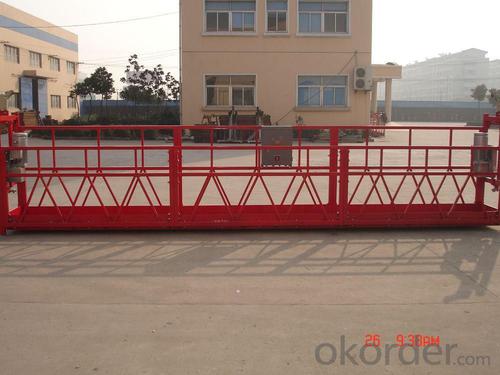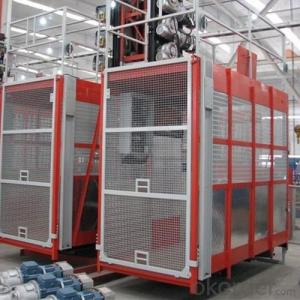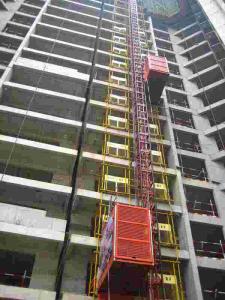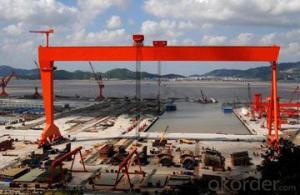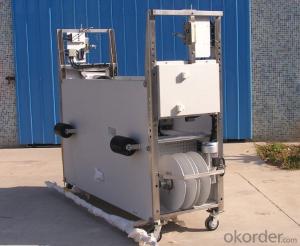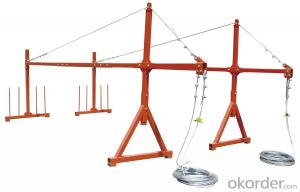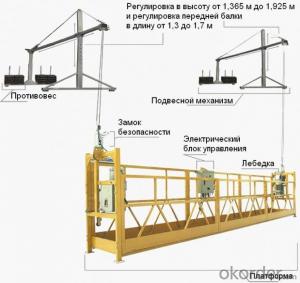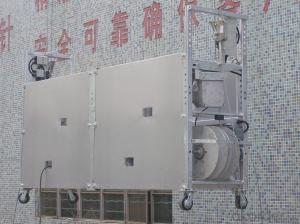Suspended Platform ZLP800
- Loading Port:
- China Main Port
- Payment Terms:
- TT or L/C
- Min Order Qty:
- 1 Set m.t.
- Supply Capability:
- 300Sets Per Month m.t./month
OKorder Service Pledge
OKorder Financial Service
You Might Also Like
ZLP series temporarily installed suspended access equipment
which is developed and produced by CNBM INTERNATIONAL CORPORA.TION, is ideal equipment for building facade construction, decoration, cleaning and maintenance. And it is also widely used in elevator installing, ship building and repairing, or in other works such as big-size tank, bridge, embankment and chimney. ZLP series versatile knock-down platforms provides workers safer, easier and more efficient platform access.
Note: the voltage and frequency could up to different countries' standard
Specification of Suspended platform ZLP800
Item | Parameters | |||
Rated capacity | 250 kg | |||
Rated speed | 9.6 m/min | |||
Platform length | 1.2m | |||
Steel rope | 4T31 | |||
Hoist | Hoist model | LTD6.3 | ||
Rated lifting force | 6.17 KN | |||
Motor | Model | YEJ90L-4 | ||
Power | 1.5 KW | |||
Voltage | AC380 V | |||
Speed | 1420 r/min | |||
Brake force moment | 15 Nm | |||
Safety lock | Permission force of impact | 30 KN | ||
Locking Cable Distance | <100mm | |||
Locking Cable Speed | ≥22m/min | |||
Suspension mechanism | Front beam overhang | 1.3-1.5 m | ||
Height adjustment | 1.365-1.925 m | |||
Weight | Lifting part (including hoist, safety lock and electric control system) | Steel Platform | 180kg | |
Suspension mechanism | 155kg | |||
Counter weight | 450 kg | |||
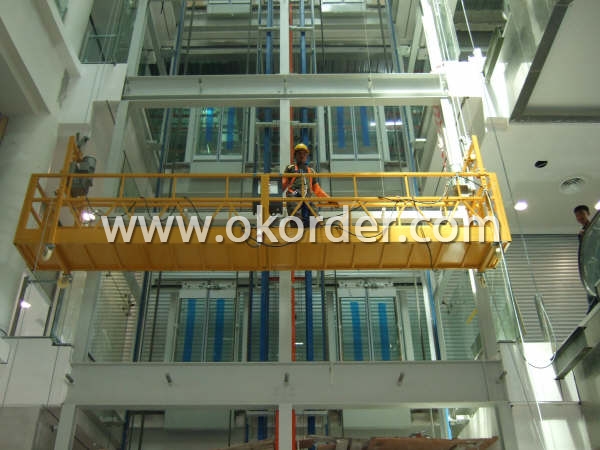

- Q: Is it possible to utilize a building hoist for the purpose of lifting small tools and equipment?
- <p>Yes, a building hoist can be used for lifting small tools and equipment, provided it is within the hoist's weight capacity. It's important to ensure that the items are securely fastened to prevent any accidents during lifting. Always follow the manufacturer's guidelines and safety regulations when using a building hoist for any lifting tasks.</p>
- Q: Can a construction elevator use a single cage
- Seriously, a construction elevator in wuhan just happened, and 19 people died. Go and see!
- Q: Is it possible to use a building hoist to lift objects that are too large to pass through a standard doorway?
- <p>Yes, a building hoist can be used for lifting objects that are too large to fit through a doorway. Building hoists are designed to handle heavy and oversized items, lifting them vertically through small openings or directly from the ground to higher floors. They are particularly useful in construction projects where large materials or equipment need to be moved to upper levels of a building. However, it's important to ensure the hoist is properly installed and operated by trained personnel to maintain safety and avoid damage to the building or the items being lifted.</p>
- Q: This question asks whether a hydraulic building hoist can be used in both indoor and outdoor environments and seeks reasons for its versatility.
- <p>A hydraulic building hoist can be used both indoors and outdoors. These hoists are designed to be versatile and durable, capable of withstanding various weather conditions when used outdoors. They are also compact and can be easily maneuvered in indoor spaces. The primary reason for their versatility is the robust construction and the ability to handle different loads with precision. Additionally, hydraulic systems are less affected by electrical interference, making them suitable for environments with fluctuating power supplies. However, it's important to ensure that the hoist is properly maintained and protected from extreme weather conditions to prolong its lifespan and ensure safety.</p>
- Q: This question asks about the process of installing a new building hoist, which is a piece of equipment used in construction to lift materials and personnel.
- <p>Installing a new building hoist involves several steps: 1) Site preparation, ensuring the area is clear and level. 2) Unpacking and inspecting the hoist components for any damage. 3) Assembling the hoist tower, starting with the base and working upwards. 4) Installing the drive unit and cable system. 5) Attaching the counterweight and safety devices. 6) Rigging the hoist to the building structure for stability. 7) Conducting a thorough inspection and testing the hoist for safety and functionality. 8) Obtaining any necessary permits and approvals. 9) Training operators on the safe use of the hoist. It's crucial to follow the manufacturer's instructions and local regulations when installing a building hoist.</p>
- Q: This question asks for methods to protect lifting equipment from damage while it is being transported or stored.
- <p>To prevent damage to lifting equipment during transportation or storage, follow these guidelines: 1. Use protective covers or wraps to shield equipment from environmental elements. 2. Securely fasten equipment to prevent movement during transit. 3. Store equipment in a dry, clean area to avoid rust and dirt accumulation. 4. Regularly inspect equipment for signs of wear or damage before and after use. 5. Follow the manufacturer's guidelines for weight limits and proper handling. 6. Use padding or cushioning materials to protect equipment from impacts. 7. Ensure that all parts are properly lubricated to prevent rust and facilitate smooth operation. By adhering to these practices, you can significantly reduce the risk of damage to lifting equipment.</p>
- Q: What precautions should be taken when using manual lifting equipment to ensure safety?
- <p>Safety measures for using manual lifting devices include inspecting equipment for damage before use, ensuring the load is within the device's weight capacity, using proper lifting techniques, maintaining a clear path for lifting, and securing the load to prevent shifting. Always wear appropriate personal protective equipment, such as gloves and safety shoes. Never exceed the rated capacity of the lifting device, and avoid sudden or jerky movements that could cause loss of control. Regular maintenance and training on safe lifting practices are also crucial to prevent accidents.</p>
- Q: Is it permissible to utilize electric or hydraulic building hoists in personal workshops or factories?
- <p>Yes, you can use an electric or hydraulic building hoist in your own workshop or factory. However, you must ensure that the hoist complies with local safety regulations and standards. It's crucial to have the hoist installed by qualified professionals and to maintain it regularly to prevent accidents. Always follow the manufacturer's guidelines and safety protocols to ensure the safe operation of the hoist.</p>
- Q: This question asks if building hoists can be utilized for extended periods of time in construction projects.
- <p>Building hoists are generally designed for temporary use in construction projects, facilitating the movement of materials and personnel. They are not intended for long-term operations. Their design and safety features cater to the specific needs of construction phases, which are temporary by nature. For permanent installations or long-term material handling, other types of elevators or lifts are more suitable. It is crucial to adhere to the manufacturer's guidelines and local regulations regarding the use and duration of operation for building hoists to ensure safety and compliance.</p>
- Q: Is it possible for a hydraulic cylinder in a building hoist to be serviced or replaced by individuals other than the manufacturer?
- <p>Yes, a hydraulic cylinder in a building hoist can be repaired or replaced by qualified individuals or companies other than the manufacturer. However, it is crucial to ensure that the service provider has the necessary expertise and follows the manufacturer's specifications to maintain safety and performance standards. Using non-genuine parts or improper installation can lead to safety hazards and void warranties. It is always recommended to consult with professionals who are familiar with the specific hoist model and have experience in hydraulic systems repair and maintenance.</p>
Send your message to us
Suspended Platform ZLP800
- Loading Port:
- China Main Port
- Payment Terms:
- TT or L/C
- Min Order Qty:
- 1 Set m.t.
- Supply Capability:
- 300Sets Per Month m.t./month
OKorder Service Pledge
OKorder Financial Service
Similar products
Hot products
Hot Searches
Related keywords



